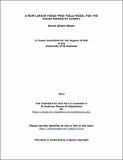A non-linear force-free field model for the solar magnetic carpet
Abstract
The magnetic carpet is defined to be the small-scale photospheric magnetic field of the quiet Sun. Observations of the magnetic carpet show it to be highly dynamic, where the time taken for all flux within the magnetic carpet to be replaced is on the order of just a few hours. The magnetic carpet is continually evolving due to the Sun's underlying convection and the interaction of small-scale magnetic features with one another. Due to this, the small-scale coronal field of the magnetic carpet is also expected to be highly dynamic and complex. Previous modelling has shown that much of the flux from the magnetic carpet is stored along low-lying closed connections between magnetic features. This indicates that significant coronal heating could occur low down in the small-scale corona. In this thesis, a new two-component magnetic field model is developed for the evolution of the magnetic carpet. A 2D model is constructed to realistically simulate the evolution of the photospheric field of the magnetic carpet, where many of the parameters for the model are taken from observational studies. The photospheric model contains a granular and supergranular flow profile to describe the motion of the small-scale magnetic features, and includes the processes of flux emergence, cancellation, coalescence and fragmentation. This 2D model then couples to a 3D model as the lower boundary condition, which drives the evolution of the coronal field through a series of non-linear force-free states, via a magnetofrictional relaxation technique. We first apply the magnetofrictional technique to consider the coronal evolution of three basic small-scale photospheric processes: emergence, cancellation and flyby. We consider the interaction of the magnetic features with an overlying coronal magnetic field, and quantify magnetic energy build-up, storage and dissipation. The magnetofrictional technique is then applied to synthetic magnetograms produced from the 2D model, to simulate the evolution of the coronal field in a situation involving many hundreds of magnetic features. We conduct a preliminary analysis of the resultant 3D simulations, considering the magnetic energy stored and dissipated, as well as regions of enhanced velocity and electric current density within the coronal volume. The simulations show that the so-called 'quiet Sun' is not quiet and a significant amount of complex interactions take place.
Type
Thesis, PhD Doctor of Philosophy
Collections
Items in the St Andrews Research Repository are protected by copyright, with all rights reserved, unless otherwise indicated.

